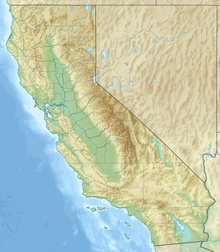Chalk Hills
| Chalk Hills | |
|---|---|

View from Chalk Hills northeast across San Fernando Valley to San Gabriel Mountains.
|
|
| Highest point | |
| Elevation | 1,086 ft (331 m) |
| Geography | |
|
Location of the Chalk Hills in California
|
|
| Country | United States |
| State | California |
| Region | Southern California |
| District | Woodland Hills |
| Range coordinates | 34°10′16.019″N 118°34′48.309″W / 34.17111639°N 118.58008583°WCoordinates: 34°10′16.019″N 118°34′48.309″W / 34.17111639°N 118.58008583°W |
| Topo map | USGS Canoga Park |
| Biome | California chaparral and woodlands |
The Chalk Hills are a north—south running low 'mountain' range in the San Fernando Valley perpendicular to and adjoining the Santa Monica Mountains. They are located in the Woodland Hills District of the City of Los Angeles in Southern California. They run between DeSoto and Winnetka Avenues, from south of Ventura Boulevard to near Victory Boulevard.
The Chalk Hills host an expansive, low density, semi-urban suburb of the San Fernando Valley.
Los Angeles Pierce College is located on the northern portion of the Chalk Hills. Historically the free-flowing Los Angeles River ran around that portion. U.S. Route 101, the Ventura Freeway, cuts deeply through the southern part since the 1960s.
The range has a white soil and bedrock, resembling chalk, and was a 'white landform' Valley landmark before suburban development on it in the 1960s. The white rocks are marine shales. Geologists are unsure of its relationship with other rock formations in Southern California, although Thomas Dibblee has identified it as a member of the Sisquoc Formation. A small remnant California oak woodland plant community remains in an undeveloped southeastern area of the Pierce campus.
...
Wikipedia

